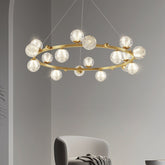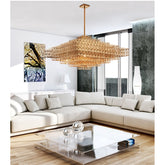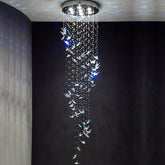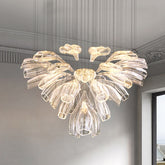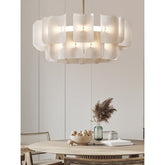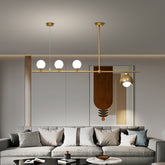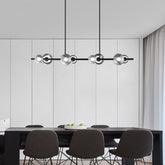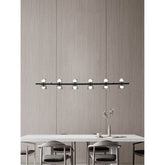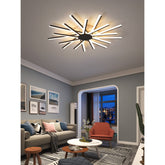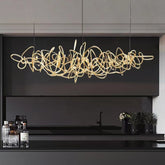Materials and manufacturing techniques for designer light products
Welcome to the ever-dazzling world of designer light products of 2023, where creativity meets innovation, and lighting becomes a form of art! The designer light industry has witnessed an exponential rise in the past few years, with the advent of new materials and manufacturing techniques that have redefined the boundaries of lighting design. But have you ever wondered how these unique and captivating products come into being? What materials are used, and what manufacturing techniques are employed to bring these fascinating creations to life?
The world of designer light products is a world of infinite possibilities, where materials and manufacturing techniques play a pivotal role in shaping the final product. From metals to glass, plastic to wood, each material brings a distinct texture, color, and character to the design, making it stand out from the rest. Similarly, manufacturing techniques such as injection molding, 3D printing, and laser cutting, among others, add an extra dimension of complexity and detail to the finished product.
According to recent statistics, the global designer light market is expected to reach a value of over $22 billion by 2026, with a CAGR of 8.3%. This staggering growth rate is a testament to the growing demand for designer light products in the market, as people increasingly seek to add a touch of elegance and sophistication to their homes and workplaces.
In this article, we will delve deeper into the fascinating world of designer light products, exploring the different materials and manufacturing techniques used to create them, as well as the role of sustainability in this industry. So, join us on this journey of discovery, as we uncover the secrets behind some of the most captivating lighting designs in the world!
Materials for designer light products
Designer light products are a playground for materials experimentation, as they push the boundaries of what is possible with different materials, textures, and finishes. From sleek and modern to warm and organic, the choice of material can greatly affect the design and functionality of a light product. Here are some of the most common materials used in designer light products and their unique characteristics.
Metal - This is a versatile and durable material that can be shaped and molded into a variety of forms. It is often used in modern and minimalist designs, where its sleek and smooth surface adds a touch of elegance and sophistication. Metals such as copper, brass, and steel are popular choices for designer light products, due to their reflective properties and ability to create a warm and inviting glow.
Glass - Glass is another popular material for designer light products, as it can be molded and shaped into a variety of forms and finishes. It is often used in contemporary designs, where its transparency and clarity can create a sense of lightness and airiness. Frosted and colored glass can add an extra layer of depth and complexity to the design, while textured and etched glass can create a unique and tactile surface.
Plastic - A lightweight and affordable material that is often used in mass-produced designer light products. It is a versatile material that can be molded into a variety of forms and colors, making it ideal for creating playful and whimsical designs. However, it is important to note that plastic is not as durable or long-lasting as other materials, and may not be suitable for high-end designer light products.
Wood - This is a natural and warm material that can add a touch of earthiness and organic texture to a designer light product. It is often used in rustic and industrial designs, where it's natural imperfections and grain patterns can create a sense of authenticity and character. However, wood is not always the most practical choice for designer light products, as it can be difficult to mold and shape into intricate forms.
Trends in material choices for designer light products vary from year to year, depending on the prevailing design trends and consumer preferences. In recent years, there has been a growing interest in sustainable and eco-friendly materials, such as bamboo, recycled glass, and reclaimed wood, which align with the values of conscious consumers. Additionally, the use of mixed materials, such as metal and wood or glass and concrete, has become increasingly popular, as designers seek to create unique and unexpected combinations of textures and finishes.
Manufacturing techniques for designer light products
Creating designer light products involves a wide range of manufacturing techniques, each with its own set of advantages and disadvantages. These techniques are used to shape and form the materials into unique and intricate designs, bringing the vision of the designer to life. Here are some of the most common manufacturing techniques used in the designer light industry.
Injection molding:
Injection molding is a manufacturing technique that involves injecting molten plastic into a mold cavity, allowing it to cool and harden into the desired shape. This technique is ideal for mass-producing designer light products with consistent and precise shapes, as it can create multiple copies of the same design quickly and efficiently. However, injection molding is limited to certain materials, such as plastic and metal, and may not be suitable for more complex and detailed designs.
3D printing:
This is a revolutionary manufacturing technique that involves creating a digital model of the desired design and using a 3D printer to create the final product layer by layer. This technique is ideal for creating intricate and detailed designer light products, as it can produce shapes and forms that would be impossible to create with traditional manufacturing techniques. However, 3D printing can be time-consuming and expensive, and may not be suitable for mass-producing large quantities of designer light products.
Laser cutting:
Laser cutting is a manufacturing technique that involves using a high-powered laser to cut through materials, creating precise and intricate shapes and designs. This technique is ideal for creating designer light products with unique and complex shapes, as it allows for precise and detailed cuts. However, laser cutting is limited to certain materials, such as metal and wood, and may not be suitable for more delicate materials such as glass or plastic.
Choosing the right manufacturing technique for a specific design and material is crucial to the success of the final product. Factors such as the complexity of the design, the material being used, and the desired quantity of the final product should all be taken into consideration when choosing a manufacturing technique. Additionally, the cost and time required for each technique should be evaluated, as well as any environmental impact of the manufacturing process.
Case studies/examples of designer light products
Now that we have explored the materials and manufacturing techniques used in the designer light industry, let's take a look at some case studies and examples of designer light products.
First, let's examine the "Arco" floor lamp by Achille Castiglioni. The lamp is made from a combination of marble, stainless steel, and aluminum, with a white diffuser to provide soft, ambient light. The base of the lamp is made from solid Carrara marble, which gives it stability and weight. The stainless-steel stem is adjustable, allowing the light to be positioned exactly where it is needed. The lamp is manufactured using traditional metalworking techniques, such as bending and welding.
Next, let's consider the "Chouchin" pendant lamps by Ionna Vautrin. These lamps are made from blown glass, with a white or orange finish, and a base made from painted aluminum. The glass is blown using traditional glassmaking techniques, creating a unique and organic shape for each lamp. The aluminum base is manufactured using injection molding, which allows for consistent and precise shapes. The lamps provide a warm and welcoming light, creating a cozy atmosphere in any space.
Finally, let's look at the "Tolomeo" desk lamp by Michele De Lucchi and Giancarlo Fassina. This lamp is made from anodized aluminum, with a polished aluminum base, and a white diffuser. The lamp is adjustable, with a swiveling arm and rotating head, allowing for optimal lighting in any workspace. The lamp is manufactured using a combination of traditional metalworking techniques and modern manufacturing techniques, such as CNC machining and laser cutting.
The materials and manufacturing techniques used in each of these designer light products have a significant impact on their design and functionality. The Arco floor lamp's use of marble and stainless steel gives it a modern and luxurious aesthetic, while the blown glass of the Chouchin pendant lamps provides a softer and more organic look. The manufacturing techniques used in each product also contribute to their unique characteristics, such as the traditional glassblowing techniques used for the Chouchin lamps, or the CNC machining used for the Tolomeo desk lamp.
Sustainability Considerations for Materials and manufacturing techniques
As we become more aware of the impact of our choices on the environment, it is essential to consider sustainability when it comes to materials and manufacturing techniques used in designer light products. The use of traditional materials such as metals and glass, as well as manufacturing techniques like injection molding and CNC machining, can have a significant environmental impact, from the extraction of raw materials to the disposal of waste.
However, there are alternative sustainable materials and manufacturing techniques available that can be used to create designer light products. For example, bamboo is a highly renewable resource that can be used as a sustainable alternative to traditional materials like wood or metal. Recycled plastics, such as those made from discarded water bottles, can also be used as a sustainable material for manufacturing.
Manufacturing techniques such as 3D printing, which use less material and generate less waste than traditional methods, can also be used to create sustainable designer light products. Additionally, upcycling or repurposing materials, such as using discarded glass bottles to create lampshades, can be a creative and sustainable way to design products.
While these sustainable materials and manufacturing techniques are available, their feasibility for use in creating designer light products must also be considered. Factors such as cost, availability, and durability must be taken into account when selecting materials and manufacturing techniques.
Final Words
materials and manufacturing techniques play a vital role in creating designer light products that are both beautiful and functional. The choice of materials and manufacturing techniques can greatly impact the design and functionality of a product, as well as its environmental impact.
It is important for designers and manufacturers to consider sustainability when choosing materials and manufacturing techniques for designer light products. While traditional materials and techniques have been widely used in the past, there are now many sustainable alternatives available that can be used to create products that are both aesthetically pleasing and environmentally responsible.
As the world becomes more conscious of the need for sustainable products, it is up to designers and manufacturers to take the lead in creating sustainable designer light products. By choosing sustainable materials and manufacturing techniques, we can reduce our impact on the environment and create a brighter future for generations to come.
So, let us all take action now! We call on designers and manufacturers to consider sustainability when choosing materials and manufacturing techniques for designer light products. Let us work together to create a better future by choosing sustainable options for our products. The time is now, let us take the first step toward creating a more sustainable future for our planet.












































































































